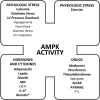AMP-activated protein kinase regulation and biological actions in the heart
- PMID: 22935535
- PMCID: PMC4397099
- DOI: 10.1161/CIRCRESAHA.111.255505
AMP-activated protein kinase regulation and biological actions in the heart
Abstract
AMP-activated protein kinase (AMPK) is a stress-activated kinase that functions as a cellular fuel gauge and master metabolic regulator. Recent investigation has elucidated novel molecular mechanisms of AMPK regulation and important biological actions of the AMPK pathway that are highly relevant to cardiovascular disease. Activation of the intrinsic AMPK pathway plays an important role in the myocardial response to ischemia, pressure overload, and heart failure. Pharmacological activation of AMPK shows promise as a therapeutic strategy in the treatment of heart disease. The purpose of this review is to assess how recent discoveries have extended and in some cases challenged existing paradigms, providing new insights into the regulation of AMPK, its diverse biological actions, and therapeutic potential in the heart.
Figures





Similar articles
-
AMP-activated protein kinase in the heart: role during health and disease.Circ Res. 2007 Mar 2;100(4):474-88. doi: 10.1161/01.RES.0000258446.23525.37. Circ Res. 2007. PMID: 17332438 Review.
-
AMP-activated protein kinase: a core signalling pathway in the heart.Acta Physiol (Oxf). 2009 May;196(1):37-53. doi: 10.1111/j.1748-1716.2009.01978.x. Epub 2009 Feb 23. Acta Physiol (Oxf). 2009. PMID: 19239414 Review.
-
[Effect of AMP-activated protein kinase on cardiovascular protection of adiponectin].Sheng Li Xue Bao. 2007 Oct 25;59(5):614-8. Sheng Li Xue Bao. 2007. PMID: 17940701 Review. Chinese.
-
AMP-activated protein kinase pathway: a potential therapeutic target in cardiometabolic disease.Clin Sci (Lond). 2009 Apr;116(8):607-20. doi: 10.1042/CS20080066. Clin Sci (Lond). 2009. PMID: 19275766 Free PMC article. Review.
-
Cardioprotective actions of Notch1 against myocardial infarction via LKB1-dependent AMPK signaling pathway.Biochem Pharmacol. 2016 May 15;108:47-57. doi: 10.1016/j.bcp.2016.03.019. Epub 2016 Mar 22. Biochem Pharmacol. 2016. PMID: 27015742 Free PMC article.
Cited by
-
Chronic AMPK activity dysregulation produces myocardial insulin resistance in the human Arg302Gln-PRKAG2 glycogen storage disease mouse model.EJNMMI Res. 2013 Jul 5;3(1):48. doi: 10.1186/2191-219X-3-48. EJNMMI Res. 2013. PMID: 23829931 Free PMC article.
-
Effect of fucoidan on ethanol-induced liver injury and steatosis in mice and the underlying mechanism.Food Nutr Res. 2021 Apr 20;65. doi: 10.29219/fnr.v65.5384. eCollection 2021. Food Nutr Res. 2021. PMID: 33994911 Free PMC article.
-
The role of AMPK-dependent pathways in cellular and molecular mechanisms of metformin: a new perspective for treatment and prevention of diseases.Inflammopharmacology. 2022 Jun;30(3):775-788. doi: 10.1007/s10787-022-00980-6. Epub 2022 Apr 13. Inflammopharmacology. 2022. PMID: 35419709 Free PMC article. Review.
-
Acute and Chronic Increases of Circulating FSTL1 Normalize Energy Substrate Metabolism in Pacing-Induced Heart Failure.Circ Heart Fail. 2018 Jan;11(1):e004486. doi: 10.1161/CIRCHEARTFAILURE.117.004486. Circ Heart Fail. 2018. PMID: 29317401 Free PMC article.
-
AMP-activated protein kinase (AMPK) activation inhibits nuclear translocation of Smad4 in mesangial cells and diabetic kidneys.Am J Physiol Renal Physiol. 2015 May 15;308(10):F1167-77. doi: 10.1152/ajprenal.00234.2014. Epub 2014 Nov 26. Am J Physiol Renal Physiol. 2015. PMID: 25428125 Free PMC article.
References
-
- Hardie DG, Carling D. The AMP-activated protein kinase--fuel gauge of the mammalian cell? Eur J Biochem. 1997;246:259–273. - PubMed
-
- Kemp BE, Stapleton D, Campbell DJ, Chen ZP, Murthy S, Walter M, Gupta A, Adams JJ, Katsis F, Van Denderen B, Jennings IG, Iseli T, Michell BJ, Witters LA. AMP-activated protein kinase, super metabolic regulator. Biochem Soc Trans. 2003;31:162–168. - PubMed
-
- Yeh LA, Lee KH, Kim KH. Regulation of rat liver acetyl-CoA carboxylase. Regulation of phosphorylation and inactivation of acetyl-CoA carboxylase by the adenylate energy charge. J Biol Chem. 1980;255:2308–2314. - PubMed
-
- Carling D, Clarke P, Zammit V, Hardie D. Purification and characterization of the AMP-activated protein kinase. Copurification of acetyl-CoA carboxylase kinase and 3-hydroxy-3-methylglutaryl-CoA reductase kinase activities. Eur J Biochem. 1989;186:129–136. - PubMed
-
- Kudo N, Barr AJ, Barr RL, Desai S, Lopaschuk GD. High rates of fatty acid oxidation during reperfusion of ischemic hearts are associated with a decrease in malonyl-CoA levels due to an increase in 5′-AMP-activated protein kinase inhibition of acetyl-CoA carboxylase. J Biol Chem. 1995;270:17513–17520. - PubMed
Publication types
MeSH terms
Substances
Grants and funding
LinkOut - more resources
Full Text Sources

